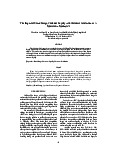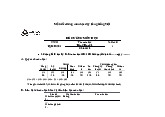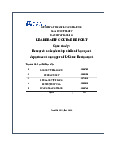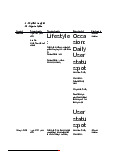



Preview text:
MINI TEST 1 PART 2 (5/10)
I. SUMMARY: Summarize this editorial published on the Washington Post in
approximately 200 words (3marks) Protect Workers' Rights By Bruce Raynor September 1, 2003
This summer Pillowtex Corp., successor to the century-old firm Fieldcrest Cannon, the
largest unionized textile company in the country, closed its 16 textile plants and let go
almost 6,500 employees in 10 states. In North Carolina, where the largest plants were
located, it was the single biggest layoff in state history.
Pillowtex is only one of hundreds of textile mills that have closed in the past several
years. For me, the Pillowtex shutdown was especially painful because for 20 years I
was involved in efforts to organize a union there. In 1999 the workers finally succeeded.
These workers overcame illegal threats, harassment and attempts to racially divide the
workers. But the hardest-working, most dedicated workers in the world could not
overcome a government policy that believes open markets and expanded trade,
whatever the cost, are always justified. Problem is, the costs keep rising and the
benefits never seem to trickle down.
The workers are now desperate. They received no severance payments. Their health
insurance is gone. Mortgages, car payments and taxes aren't being paid. Kannapolis,
N.C., where Pillowtex is located, has always been a textile town. There are no other
jobs available. And while the union is still trying to find a buyer for the company, the
local government's response for economic development is to buy an ad in USA Today or
the Wall Street Journal asking Bill Gates, Oprah Winfrey or Warren Buffett to consider
moving some of their business operations to Kannapolis.
What happened to Pillowtex workers is illustrative of destructive trends that threaten
American prosperity and, indeed, the global economy.
Every manufacturing industry in the United States -- apparel, textiles, metals, paper,
electronics -- has lost jobs in the past year. Over the past 36 months manufacturing
employment has declined by 2.7 million. This is the longest decline since the Great
Depression. The job crisis is not only in manufacturing. Since the economic recovery
began, more than a million jobs have disappeared. Apparently the economy is doing
well. Only workers are suffering.
The usual response of policymakers to manufacturing workers who have lost their jobs
is to preach the virtues of education. Workers are told that if they would only acquire
new skills, they would qualify for white-collar service jobs that are safe from the
economic forces that have shifted millions of factory jobs to foreign countries. Perhaps that was once true.
Today white-collar jobs -- telemarketing, accounting, claims adjusting, home loan
processing, architectural practices, radiographers and even some state and local
government jobs -- are going offshore. In a survey of the world's 100 largest financial
services firms, Deloitte Research found that these companies expect to shift $356 billion
worth of operations and about 2 million jobs to low-wage countries over the next five
years. These developments appear already to be affecting wages in some sectors.
According to Sharon Marsh Roberts of the Independent Computer Consultants
Association, outsourcing has forced down hourly wage rates by 10 percent to 40
percent for many U.S. computer consultants.
These trends also affect workers in developing countries. For example, since January
2000, 520 manufacturing plants have closed in Mexico, most of them moving to China.
And in 2005, when all apparel and textile quotas are to be lifted, developing countries
around the globe will be faced with a massive loss of jobs as the industry moves into
China. For example, a United Nations study predicts that Bangladesh will lose 1 million
apparel jobs when quotas are abolished. Many other countries in Africa, Asia, the
Caribbean and Eastern Europe, where the apparel industry is the largest employer, will
also suffer huge job losses when quotas are lifted.
As low as wages are in many developing countries, they can't compete with the pennies
an hour paid in China. China scholar Anita Chan describes how different regions in
China seek to maintain their attractiveness to foreign capital by lowering minimum
wages and not enforcing labor regulations and health and safety laws. According to
Chan, "though employment in the low-wage industries in China may be expanding, the
wages of the workers in these industries are not rising, and for many of them have been
falling." The benefits of globalization, Chan warns, "will not trickle down to those who make products."
So it turns out that workers in Kannapolis, N.C., Silicon Valley, Calif.; Juarez, Mexico,
and Guangdong, China, have much in common. It is becoming increasingly clear that
when wages and conditions of work are undercut in one part of the globe they will
eventually be cut in others as well.
The downward spiral of lower wages and worsening working conditions is fueling
popular skepticism over globalization. A prosperous economy requires that workers be
able to buy the products that they produce. That means we need rules for the global
economy that protect workers' rights - and not just in China - we also need then in the United States.
(The writer is president of UNITE, a union of 250,000 apparel, textile, laundry and distribution workers.)
II. PARAPHRASING (2 marks)
"To Paint Is to Live": Georgia O'Keeffe, 1887- 1986
Georgia O'Keeffe is truly an American original. Tough, sparse, lean, she embodies the
rugged individualistic nature of the American pioneer. But instead of tilling the soil, her
strides have been made in the field of contemporary American art.
Born on a 600-acre farm in Sun Prairie, Wisconsin, on November 15, 1887, O'Keeffe
throughout her long life has always preferred vast plains and open spaces to city living.
From the summer of 1929, when she made her first visit to New Mexico, the starkness
of the desert has fascinated her. After summering in New Mexico for many years, she
finally moved permanently to Abiquiu, New Mexico, in 1949, where she continued to
paint until her eyesight faltered in the late 1970s. From this region the themes of some of her finest works evolved.
O'Keeffe's strictly American art education began with private lessons at the age of ten.
Teachers recognized her talent but often criticized the larger-than-life proportions that
she liked to paint. At an early age she was already moving away from realistic copying
of objects to things she perceived with her own eyes, mind, and soul. O'Keeffe's formal
high school education continued at a private school in Madison, Wisconsin, and after a
family move, she graduated from a Williamsburg, Virginia, high school in 1903. In 1905-
06 she studied at the Art Institute in Chicago, and in 1907-08, at the Art Students'
League in New York. In 1908, perhaps disappointed with the rigidity of American art
education at the time, she gave up painting and became a commercial artist, drawing
advertising illustrations in Chicago. However, in the summer of 1912, she decided to
take another art course in Virginia under Alon Bemont, and her interest in creative
painting came alive again. Self-supporting since graduation from high school, O'Keeffe
had to find jobs to sustain her through her developing years as an artist. In 1912, she
began to teach in Amarillo, Texas, and was stunned by the barren southern landscape.
"That was my country," she said, "terrible wind and wonderful emptiness." After art
courses in 1915-16 in New York under the more liberal art teacher Arthur Dow, O'Keeffe
accepted a position as an art teacher at a small college in South Carolina. It was at this
point that the determined young woman locked herself up, took stock of her painting,
and decided to reject the rigidity of the realism that she had been taught for a style all
her own. "Nothing is less real than realism - details are confusing. It is only by selection,
by elimination, by emphasis, that we get the real meaning of things." From this revival
came black and white abstract nature forms in all shapes and sizes, the beginning of
her highly individualistic style.
O'Keeffe sent some of these prints to a friend in New York and told her not to show
them to anyone. The friend was so impressed with them that she ignored the request
and took them to a famous photographer and promoter of modern artists, Alfred
Stieglitz. His reaction was immediate: "At last, a woman on paper!" Without O'Keeffe's
knowledge or consent, Stieglitz exhibited these prints in his gallery, 291. Infuriated, she
went to New York to insist that he take her drawings down. Stieglitz, however, convinced
her of their quality, and she allowed them to remain on exhibit. Subsequently, Stieglitz
became the champion of O'Keeffe's works and helped her gain the prominence she
deserved. For Stieglitz, Georgia was an unusually talented American female artist. She
was unspoiled by studies in Europe and painted with a direct, clear, strong—even fierce
—force. The relationship between Stieglitz and O'Keeffe developed into a passionate
love affair, which eventually led to a twenty-two-year marriage. Stieglitz, his wife's senior
by many years, died in 1946. He immortalized her through many beautiful and unusual
photographs— the lady in black, with piercing eyes, tightly pulled-back hair and the
artistic elongated hands of a goddess. Strength, clarity, and strong physical presence
are words that are often used to describe O'Keeffe's paintings. As art critic Lloyd
Goodrich said, "Her art presents a rare combination of austerity and deep seriousness. .
. . Even at her most realistic she is concerned not with the mere visual appearance of
things, but with their essential life, their being, their identity. . . . The forms of nature are
translated into forms of art.'' Or, as O'Keeffe herself put it, "A hill or a tree cannot make a
good painting just because it is a hill or a tree. It is lines and colors put together so that
they say something. For me, that is the very basis for painting. The abstraction is often
the most definite form for the intangible thing in myself that I can only clarify in paint.”
Source: “To paint is to live” (Miki Knezevic)
Paraphrase the following excerpts from the above article.
1. "Tough, sparse, lean, she embodies the rugged individualistic nature of the American
pioneer. But instead of tilling the soil, her strides have been made in the field of contemporary American art."
………………………………………………………………………………………………………
………………………………………………………………………………………………………
…………………………………………………………………………………………
2. "Self-supporting since graduation from high school, O'Keeffe had to find jobs to
sustain her through her developing years as an artist."
………………………………………………………………………………………………………
………………………………………………………………………………………………………
………………………………………………………………………………………………………
3. '"Nothing is less real than realism—details are confusing. It is only by selection, by
elimination, by emphasis, that we get the real meaning of things.'"
………………………………………………………………………………………………………
………………………………………………………………………………………………………
………………………………………………………………………………………………………
4. '"Even at her most realistic she is concerned not with the mere visual appearance of
things, but with their essential life, their being, their identity.'"
………………………………………………………………………………………………………
………………………………………………………………………………………………………
………………………………………………………………………………………………………




